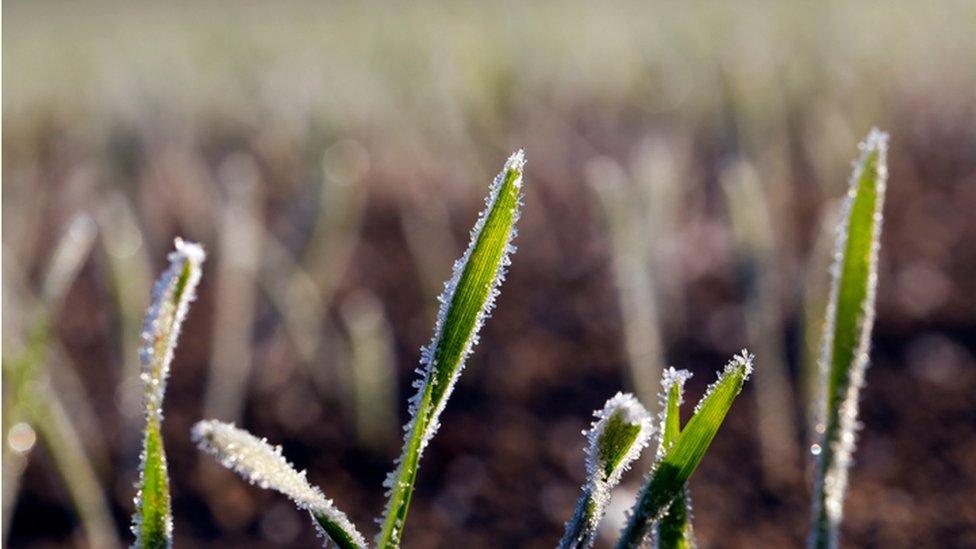Hard frost on Scotland's economy
- Published

The latest figures for output from the economy show double the rate of growth in the second quarter of last year. But as that was 0.1%, it couldn't have been lower without stalling.
The rise in Gross Domestic Product (GDP) was half the rate of growth of the whole UK, which at 0.4% is not good either.
Scottish growth has recently been little more than a third as strong - 0.6% growth over the year to September, compared with 1.7% for the UK.
Economic output per head hasn't improved for two-and-a-half years, and it's barely risen from the level it was at 12 years ago.
The latest figures look worse when set against the Scottish government's other target for growth - to match the small country average across the European Union.
The most recent figures put it three percentage points lower than those countries. So that looks less of a target than a distant dream, for now.
The price of Brexit is a possible explanation for the performance being so much smaller than Sweden to Slovenia, but it doesn't explain why Scotland has been growing more slowly than the whole UK.
So from these figures, there's not much sign of green shoots in the Scottish economy. It looks more like a continued hard frost.
That's despite the help to exports of sterling's weakness.
And more recent evidence, from 500 companies surveyed in December for the monthly Purchasing Managers Index, showed their output levels were getting even worse than last summer, and have been contracting.
Volatile
You have to go back three years to see robust figures.
Since the start of 2015, there have been only two quarters when growth has been above the anaemic 0.2% mark. Two quarters saw no growth, and two registered a contraction. So what has happened, according to this data?
The construction sector has slowed up. Big infrastructure projects have been winding down and completed, so you could say it is back at more normal levels. From the peak at the end of 2015, construction output is down nearly 15%.
Though it's impact is unclear for now, the collapse of Carillion construction giant certainly won't help, particularly amid the supply chain and sub-contractors.

The energy sector has proven volatile. The figures don't include offshore oil and gas production, but they do include the sector that services the offshore producers. That category has fallen with the oil price and the end of some big investment projects - down 17% since the start of 2015.
There are a number of signs that the oil sector decline has bottomed out in the past year, and output is now more steady, so it ought to become less of a drag on the rest of the economy.
A rising source of volatility is renewable energy. A good quarter of wind, and output rises sharply. Between July and September, production was up 8%.
Over a longer period, these figures suggest the output from wind turbines has replaced the economic contribution from Cockenzie and Longannet coal-burning power stations, which closed in recent years - at least by this measure. And when the wind drops? Not so much.
Global economy
For most Scots, including most in the public sector, work is in the services category, representing three-quarters of the economy.
That has been growing slowly and steadily, though there are signs of the very large business services and finance category stalling over the past year. It represents more than quarter of the whole economy.
Manufacturing is easily seen as a symbol of output, though it represents only 11% of the economy.
By this measure, less is made in Scotland than in 1998. It is having a better run, helped by exports into a strengthening global economy. But compared with the UK, again it doesn't look good.
Since the start of 2015, Scottish manufacturing is down nearly 6%, while UK output is up 3%.
Puzzling
The reason for this growth pattern remains a puzzle for economists. The oil and gas slowdown does not explain it all.
But all are agreed that stagnant productivity is key to getting things moving again. When measured by output per head, as the population grows, Scotland saw no growth at all in the third quarter of last year, and the UK saw growth of only 0.1%.
Indeed, Scottish growth per head hasn't grown at all for 10 quarters. That's right: two-and-a-half years, with growing employment, and no more total output per head.
Compared with the pre-crash year, 2006, output per head is only 1.4% higher.
So it makes sense - though it seems late to start this - that three of the country's think tanks - the David Hume Institute, the new Scottish Policy Foundation and the Fraser of Allander Institute - are joining forces to find out more about what's happening with productivity, and what can be done about it.